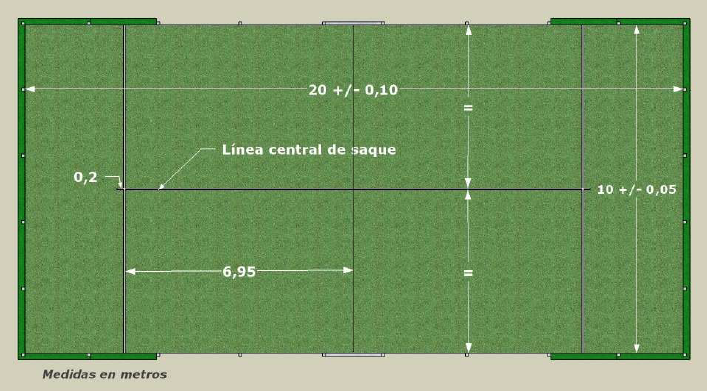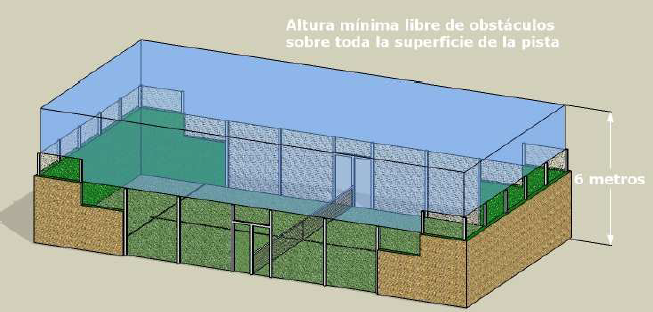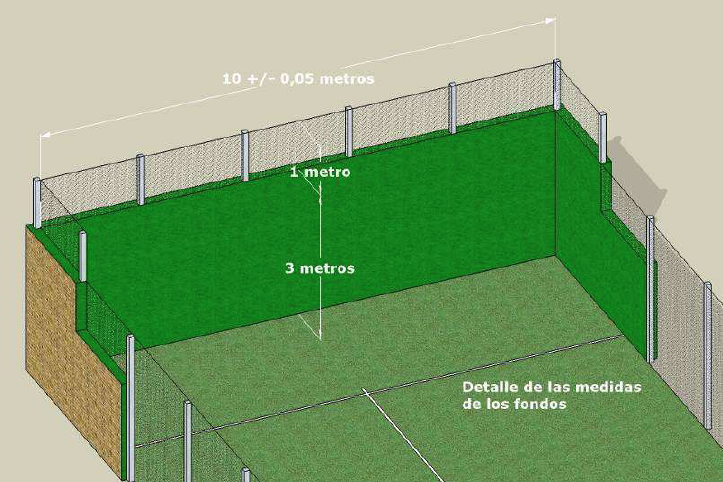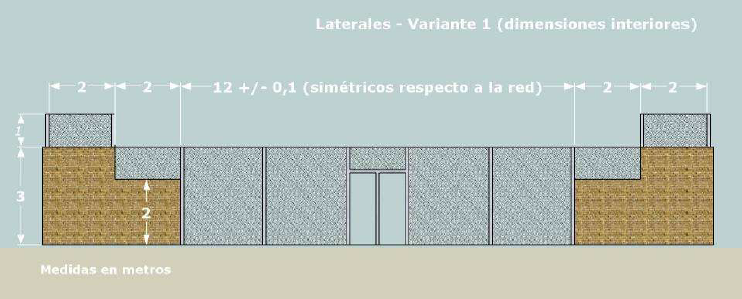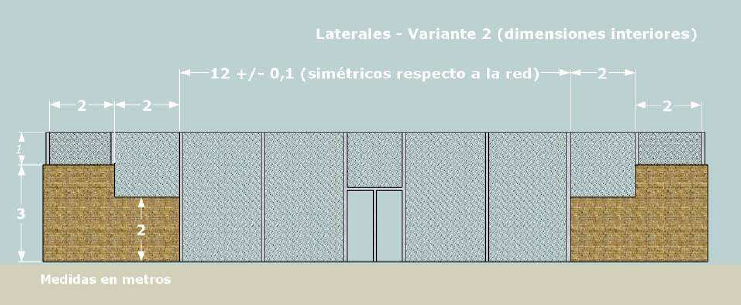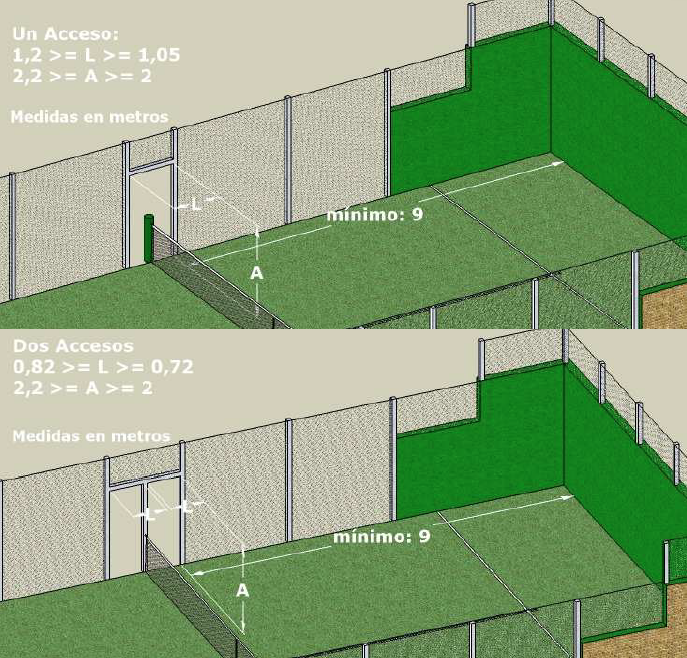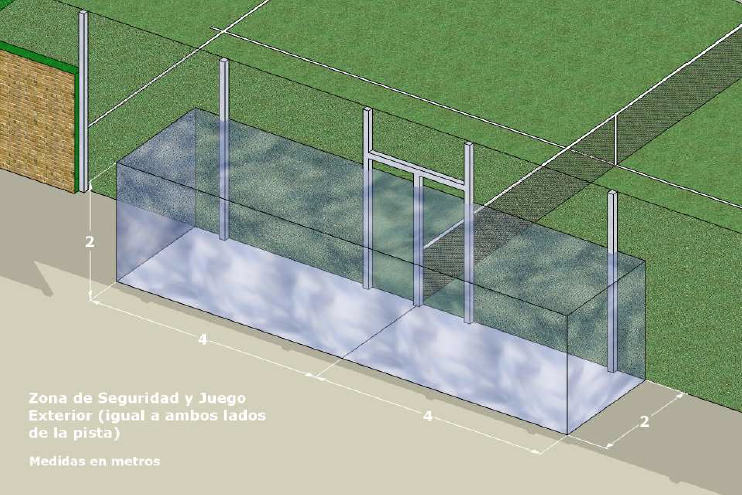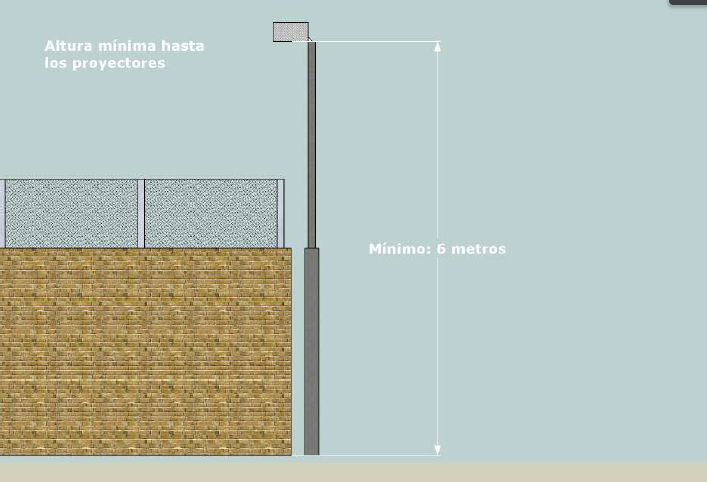How to play padel? |
The court DIMENSIONS The playing area is a rectangle of 10 meters wide per 20 meters long (inside measurements) with a 0.5% of tolerance. This rectangle is divided in half by a net. On both sides, parallel to the net and at a 6.95m distance, service lines are found. The area between the net and the service lines is divided in half by a perpendicular line called central line, and it creates two equal zones. The service centre line will extend 20 cm beyond the service line. The two halves of the court have to be completely symmetrical with respect to surfaces and drawing lines. All lines have a width of 5cm.
The minimum height is 6 meters in the whole surface of the court, without any element (ex.: focus) to invade this space.
NET The net is 10 meters length and 0.88 meters height in the centre. At the ends it is raised to a maximum of 0.92 meters (with a maximum tolerance of 0.005 meters).
It is suspended by a wire cable with a maximum diameter of 0.01 m, the ends of which are attached to two lateral posts with a maximum height of 1.05 meters, or to a structure that holds and tenses the net. The cable tension device should be conceived so as not to come loose unexpectedly. It cannot constitute a risk to the players. The outer faces of the net’s post coincide with the lateral limits of the court (opening door or mesh). They can be circular or square, but always with rounded corners. The net is topped with a white top band of a width between 5 and 6.3 cm. Once folded, a cable passes through its interior to hold the net. It may have publicity, whenever is only of one colour. The net must be fully stretched so that it completely fills the space between the posts and the surface of the court, leaving no space between the ends of the net and the posts. However, its hold not be too tighted. The threads composing it, will be made out of synthetic fibbers and the mesh width will be small enough to prevent the ball from passing through.
CLOSINGS The court will be entirely closed by ends of 10 meters long, and by laterals with an internal length of 20 meters.
All closings combine areas made up of materials that allow a regular rebound of the ball and metal mesh areas in which the rebound is irregular, as follows: ENDS With a total enclosure of 4 meters high, composed of three meters wall and a last meter of wire mesh. LATERALS According to regulations, two variants in the lateral closings are allowed: Variant 1 It is composed by stepped wall areas. The first panel is 3 meters high and 2 meters long and the second panel is 2 meters high per 2 meters long at both ends. Mesh zones complete the closing up to 3 meters high in the 16 central meters to the 4 meters high in the two meters of the ends. Variant 2 It is composed by stepped wall areas at both ends. The first panel is 3 meters high and 2 meters long and the second one is 2 meters per 2 meters long. Mesh zones complete the enclosure to 4 meters over the entire length of the enclosure.
The above mentioned dimensions are from the inside of the track. The metallic mesh is placed aligned with the inner surface of the walls, which can be of any material; opaque or transparent(brick, glass etc.). Whenever they offer the appropriate consistence and a regular and uniform ball bounce. Independently of the material, the finishing of the wall must be even, tough and smooth without any rugosity. In this way, the contact, the friction and gliding of balls, hand sand bodies will be easier. The colour of the opaque wall smuts be plain and will not interfere in the player’s vision nor the game’s conditions. As for the glass courts, the regulation for temper glass must be fulfilled. European Union: UNE – EN 12150-1. Other countries: look up their own regulations. The metallic mesh must be rhomboidal or square, of simple torsion or electro welded, as long as the dimensions of its opening (the measure of its diagonal lines) is not less than 5 cm nor more than 7.08 cm. The thickness of the steel’s wire diameter must be between 1.6 mm and 3 mm (up to 4 mm) and its tension must allow the rebounding of the ball. If an electro welded mesh is used, all the welded points must be protected both in the inside and the outside of the court, so they cannot cause cuts or scratches. If the electro welded mesh is not interlaced, the assembly will be square, not rhomboidal, and steel wires parallels to the ground should be in the inner part of the court whereas the vertical ones in the exterior. If the mesh is of simple torsion, the struts must be placed in the outside of the court, also suitably protected. The unions or sewing’s between the mesh rolls must not have any sharp element. Both the electro welded mesh and the simple torsion one must form a flat and vertical surface and they must maintain their position so as not lose these features.
Ground The court’s surface may be of porous concrete, cement, wood, synthetic materials, artificial grass or any other material which allows the ball to bounce regularly and prevents the court from getting flooded. The colour can be green, blue or earthy brown. The surface should be flat, with some inner level differences below 3 mm, measured with a 3-meters-ruler (1/1000). In non-draining surfaces, the maximum transverse evacuation slope will be of 1%, always from the centre to the outside of the court. Synthetic and artificial grass surfaces must meet the following requirements:
Accesses Court’s accesses are symmetric in relation to the centre and they are located on the laterals. There may be one or two openings on each side, with or without door (see rule 16 of the game). The openings’ dimensions must be as follows: 1) With a single lateral access: the clear opening must have a minimum of 1.05 x 2 meters and a maximum of 1.20 x 2.20 meters (see figure). 2) With two accesses by lateral side: each clear opening must have a minimum of 0.72 x 2.00 meters and a maximum of 0.82 x 2.20 meters (see figure).
Note: The public facilities must comply with the rules of accessibility and removal of architectural barriers for people with disabilities. The minimum distance between the back wall and the nearest wall to the opening will be of 9 meters. In case of having doors, handles must be placed on the courts outside without any elements protruding inwards.
SAFETY ZONE AND EXTERIOR GAME Each of the court’s laterals must have two access openings. There should not be any physical obstacle outside the court in a minimum of 2 meters wide per 4 meters long and 2 meters high on each side. (See graphic).
Lighting Artificial lighting will be uniform and so as to not difficult the view of players, spectators or referees. It will obey the following rule: - Unión Europea: UNE-EN 12193 “Iluminación de instalaciones deportivas”, y contará con los siguientes niveles lumínicos:
- Other countries: see their own regulations. Lighting columns are situated outside the court. If they were located in the security zone, the outside game would not be permitted. The minimum height measured from the floor to spotlights’ bottom floor must be of 6 meters.
A minimum level of vertical lighting of 1.000 lux is required for TV colour broadcasting and movie recording. However, this value may increase with the distance between the camera and the object. For more information the rule mentioned should be consulted.
Orientation It is recommended that the court’s longitudinal axis in outdoor installations is N-S. A variation between N-NE and N-NO is admitted. |

Pça. Ciutat de Figueres, núm.1 baixos local 3
Girona 17003 - SPAIN

